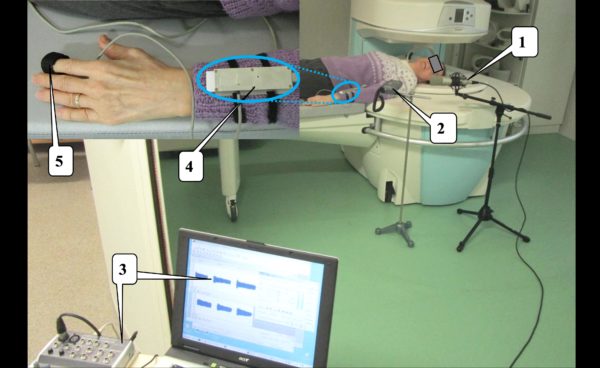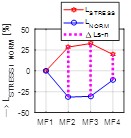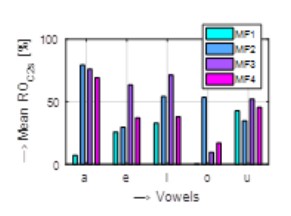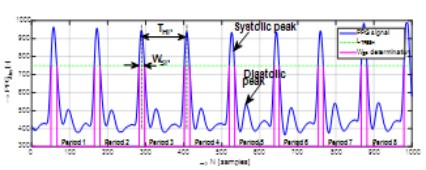Stress detection and evaluation from phonation and PPG signals recorded in an open-air MRI device working with a low magnetic induction
Investigators: Přibil Jiří, Přibilová Anna, Frollo Ivan
In many people, exposure to acoustic noise and/or vibration causes negative psychological reaction that can be identified with negative emotional states of anger, fear, or panic. Recognition of these negative affective states in the speech signal of the noise-exposed speaker may be used as another stress indicator. The stress associated with the autonomic nervous system is expressed by higher pulse rate variability assessed from the photoplethysmographic (PPG) wave and as a heart rate (HR) variability detected from the electrocardiogram (ECG).
Our current research is focused on stress detection and evaluation from speech records of vowel phonation picked up with parallel measurement of cardiovascular parameters using a PPG wearable optical sensor. Phonation signals of basic five vowels were recorded in states without any negative stimulation and after exposition to vibration and noise during scanning in the open-air MRI tomograph with a low magnetic induction. Two methods for stress level evaluation were applied: the first proposed method uses the recorded phonation signal. From this signal, different speech features are determined for next statistical analysis and evaluation by a classifier based on the Gaussian mixture model (GMM) approach. The second stress evaluation method gives comparison of the results obtained from the statistical processing of HR and Oliva-Roztočil index values determined from the PPG signal. It is supplemented by comparison of energetic, time, and statistical parameters describing the sensed PPG waves. The fusion of the results obtained from both types of stress analysis methods gives the final stress level.
An arrangement of the phonation and PPG signal recording in the MRI Opera: (1) pick-up microphone, (2) noise SPL meter, (3) phonation and PPG recording devices, (4) detail of the electronic part of the wearable PPG sensor, (5) detail of the reflection optical pulse sensor placed on the forefinger.
Example of GMM-based classification of a phonation signal recorded in four measuring phases: mean relative occurrence values for stressed speech classes per each vowel (left), graph of the final stress and normal factors and their differences (right).
Visualization of the 1k samples of a PPG signal with localized systolic heart peaks, determined heart pulse periods THP, and widths WSP of systolic peaks.
Related projects:
- VEGA 2/0003/20 “Imaging methods based on the magnetic resonance for medical diagnostics and materials research”.
- COST Action CA16116 “Wearable Robots for Augmentation, Assistance or Substitution of Human Motor Functions”.
- APVV-19-0531 “Personalized Optimisation of Cardiac Resynchronization Therapy in Heart Failure Based on Multiple Lead ECG Measurement”.
The obtained results will be used for analysis, quantification, and suppression of the stress factor having an influence on the speech signal recorded during scanning in the MRI device for three dimensional modeling of a human vocal tract. This type of non-invasive observation technique is used in medical practice – for observation of the postoperative state of vocal cords, or/and for automatic conservation and reconstruction of the voice of patients after a total laryngectomy.
Publications:
- PŘIBIL, Jiří – PŘIBILOVÁ, Anna – FROLLO, Ivan. Stress level detection and evaluation from phonation and PPG signals recorded in an open-air MRI device. In Applied Sciences, 2021, vol. 11, no. 24, art. no. 11748. (2.679 – IF2020) Q2. Available online: https://doi.org/10.3390/app112411748. Type ADMA
- PŘIBIL, Jiří – PŘIBILOVÁ, Anna – FROLLO, Ivan. Experiment with stress detection in phonation signal recorded in open-air MRI device. In 44th International Conference on Telecommunications and Signal Processing (TSP 2021), 2021, p. 38-41. ISBN 978-1-6654-2933-7. Q4. Type ADMB
- PŘIBIL, Jiří – PŘIBILOVÁ, Anna – FROLLO, Ivan. Two realizations of the wearable PPG sensor working in reflectance mode for measurement in weak magnetic field. In Engineering Proceedings, 2021, vol. 3. Available online: https://sciforum.net/paper/view/11252. ISSN 2673-4591. Q4. Type ADMB
- PŘIBIL, Jiří – PŘIBILOVÁ, Anna – FROLLO, Ivan. PPG Signal Measurement in Weak Magnetic Field by a Wearable Sensor. In A. Dvurecenskij, J. Manka, J. Svehlikova, and V.Witkovsky (Eds.): Proceedings of the 13th International Online Conference MEASUREMENT 2021, Smolenice Castle, Slovakia, May 17-19, 2021, Section: Measurement in Biomedicine I, pp. 126-129. ISBN 978-80-972629-4-5. Type ADNB
 Contacts
Contacts Intranet
Intranet SK
SK



